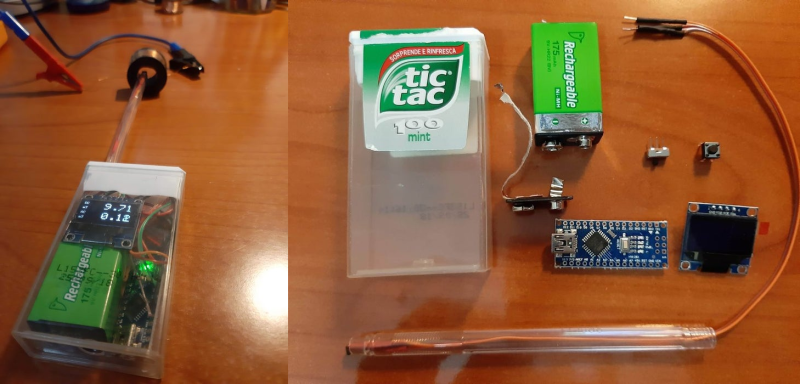With the rise of affordable 3D printers, we just don’t see the projects in Tic Tac boxes that we used to. That’s kind of a shame. Not only are you upcycling existing plastic when you use one, they’re decently sized component vessels for pocket builds such as [rgco]’s portable magnetometer, especially if you can get the 100-count box. Best of all, they’re see-through!
Sure, you could get a magnetometer app for your phone to test out the strength of your Buckyballs, but this is more fun, and you can use it in more places. This build doesn’t take much — an Arduino Nano reads from a Hall effect sensor and outputs the magnetic flux density in militeslas (mT) on an OLED. Fortifying the sensor by mounting it inside the body of an old (also see-through!) ballpoint pen body is a nice touch.
In order to calibrate it, [rgco] made a solenoid by wrapping a length of PVC with magnet wire. The code for this very portable and low-cost magnetometer measures the magnetic field 2000 times in under three-tenths of a second, and outputs both the mean and the standard deviation of these measurements.
Magnetometers can ID all kinds of things from submarines to Suburbans. Here’s an ESP8266 magnetometer that opens a driveway gate when it detects the car.















So… feel without the actual feeling? :) Why not add a small vibration motor inside to get the feeling for the force?
I second this!
+1
Or “smell the force” – we need a olfactory transducer.
Skatole on a piezo?
Supposedly, there’s 7 basic smells, so you just need to hook those up in tiny tanks with inkjet/bubblejet tech, figure the right set of 7 8 bit values for each smell that exists, and walk around with a smell printer on your schnoz.
When I first read this I was envisioning a strong magnet on a spring with an analog readout. Not a bunch of electronics that are not at all unique.
+1
I also don’t like the fact that most of the ‘DIY’ community is actually a ‘DIYRCGACKCTFJWLWSEWTLCWAA’ community (Do It Yourself from Random Chinese Garbage Assembled by Chinese Kids by Connecting Together a Few Jumper Wires and Loading a Few Arduino Libraries Written by Someon Else and Writing Thirty Lines of Code and then Writing an Article About it).
+1 For the acronym.
You are right. I wish we only had discreet parts with no handy, pre-built components or libraries. I wish no one ever wrote about how to combine them in interesting ways. All these simple components, libraries, and write-ups might cause the common person to get uppity and think they could actually build something themselves instead of asking a priest of the electrical engineering class. Stop being an elitest.
It’s not about beeing an elitest, but this guy is not completly wrong. There are people that just stuck together prebuild modules (hardware) and prebuild libraries (software) and then boast about (?) their awesome build and their skills and so on. This is tiring.
Happy New Year (the greeting is good for 30 days).
Those folks are called “systems engineers”. They take pre-built modules and software and create something useful with them. Usually in manufacturing process and control type environments.
It still takes a skill to resource the modules and software then stitch them together,
Peace and blessings.